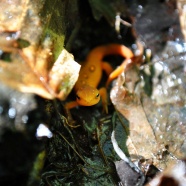Dragons of the Northeastern Forest?
Do you still consider yourself to be a kid at heart? I definitely have my own “kid” moments when I’m out in the field flipping logs or dip netting pools to see what may be living beneath the surface of the forest floor or a body of water. One species in particular that I love to find in our northeastern forests is the spotted salamander (Ambystoma maculatum). Known for their large black bodies spotted with bright yellow dots, this charismatic species is hard to miss when out in the open. However, they are typically only seen out and about once a year; during their spring...
Read MoreZombie Fungus?
During a recent Hemlock Woolly Adelgid survey, one of our volunteers found a little yellow blob attached to a hemlock twig. The mass was clearly not HWA, but curiosity prompted me to bring it back to the office for examination. A closer look under the microscope revealed that the blob actually consisted of a powdery fungus encapsulating a dead spider! After a bit of research, I came to suspect that it might be some sort of Cordyceps; a genus of parasitic fungi capable of taking control of an arthropod, thus directing it to navigate to a favorable position for the fungi’s spores to...
Read MoreSlimy Salamander (Plethodon glutinosus)
There’s always that one subject that is particularly challenging to photograph, and for me it’s the Slimy Salamander. They live in dense forests where the light is quite low and they quickly retreat from bright light, so without a high shutter speed your chances of capturing these secretive salamanders is next to none. What’s more, their jet black body and eyes makes it difficult to get the focus just right. And if you try to move them into a better position, your fingers get coated in their gooey secretions and then you stick to anything else you touch! These elusive...
Read MoreDark-eyed Junco
The Dark-eyed Junco (Junco hyemalis) is one of our most familiar backyard feeder birds. They are a species we can find year-round as they nest in some of our woodlands in western New York. They used to be known as the “snowbird” likely because of their abundance in pouring down from the north into all of the continental United States during the winter. Their plumage, grays and browns above with white below, also seem to fit so perfectly on a snowy landscape. This bird was photographed during a recent snowstorm looking regal as can be while living up to its name. Have you ever...
Read MoreNot All Salamanders Are Newts…
If you’re an amphibian enthusiast, you’ve probably heard this phrase at some point: “All newts are salamanders but not all salamanders are newts.” Does trying to make sense of this cause smoke to come out of your ears? You’re not alone. To shed some light on this conundrum, let’s first consider a bit of taxonomy. Within the Class Amphibia there are three Orders: Caudata, Anura, and Gymnophiona. Caudata refers to the salamanders; species that retain their tails as adults and have four legs. These differ from the Anurans (frogs) which lose their tails as...
Read MoreBobcat
They say any evening you spend with a Bobcat is a good evening – okay, maybe they don’t, but I did, and I do, so here’s a photo of a Bobcat that I took about an hour ago after sunset. What a magnificent creature! We will be buried in snow tomorrow in Connecticut, and I hope it comes back to play then. Scott Kruitbosch Conservation & Outreach Coordinator
Read More









